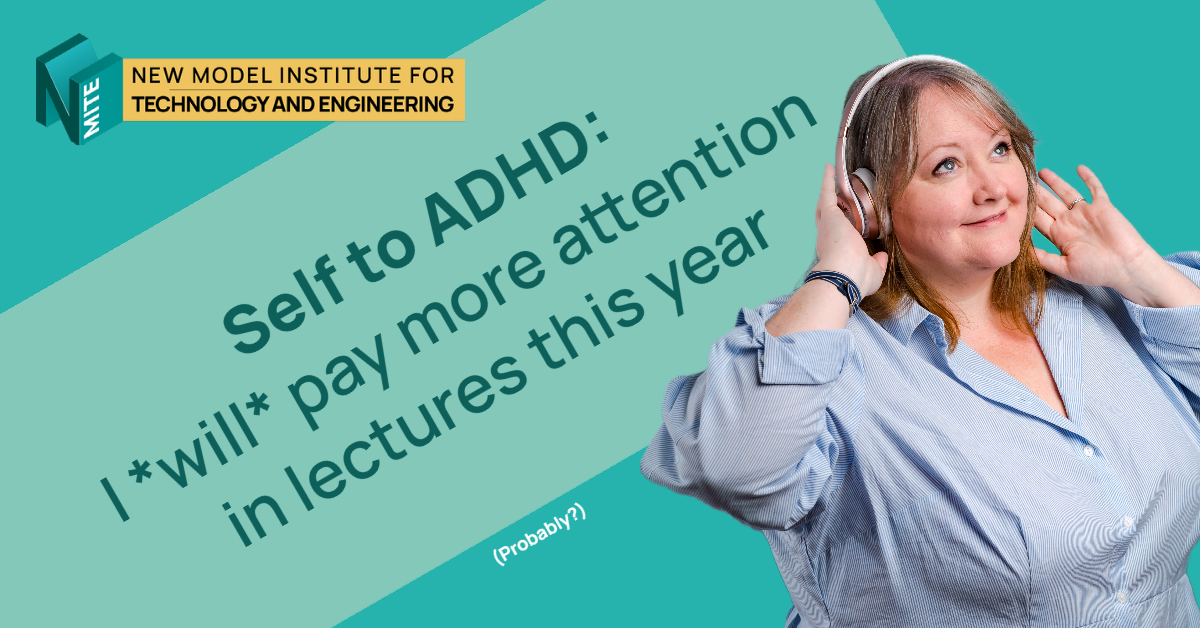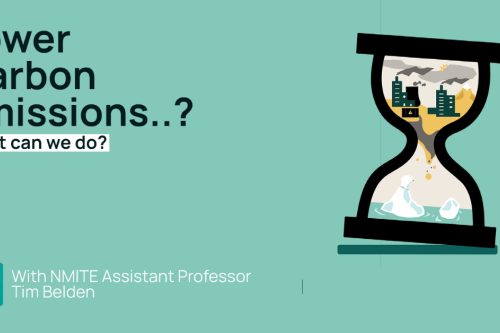
Self to ADHD: I will pay more attention in lectures this year
5 top tips for supporting concentration (and not a fidget toy in sight!)
Heading into a new academic term at University with New Year Resolutions? Here are my 5 top tips for supporting concentration once you’re in the room, and I’m not going to mention a fidget toy once.
Perhaps you always make resolutions, and this year you want to get the best out of your studies. Or perhaps you’re coming out of January’s exams feeling a bit bruised and determined to do better. There is quite a lot of material on the web that can help you get organised and look after yourself…..maybe, sometimes, you even take notice of some of it. You’ve taken your medication, you’ve woken up, you’ve had breakfast, got out of the house, and you’ve even got there on time.
But what happens when you’ve finally got there? You’re in the lecture hall, classroom or studio….and after 15 minutes your mind starts wandering all over the place and your skin starts tingling because you JUST NEED TO MOVE?
We’re here to help! Here are our 5 top tips for managing the bodily amble and the mental ramble involved in being a student with ADHD.
- Get actively involved. Yes, I went there first. In fact, I’m going even further, to suggest that you make eye contact with the lecturer. Don’t sit at the back of the lecture hall in the dark and wonder why your mind is wandering. There is lots of research showing that students who sit towards the front and centre of lecture theatres are more engaged, enjoy the course more, and perform better academically, but we don’t definitely know whether they sit their because they’re engaged and able, or whether sitting there increases their engagement and achievement. If you sit where you’re visible, you make yourself more accountable, and that’s helpful.
- Make good notes by hand, and use colour if you can. It doesn’t matter whether you are understanding the information, or even whether you already know it. That’s not why you’re making notes – you’re making notes to exploit the hand-brain connection, keep you engaged, and force yourself to synthesise the information you’re hearing. The fact that you can’t write every word being said is an opportunity here, not a cause for worry. Colour is brilliant - if you’re not a pencil case kind of person then what’s wrong with you grab a trusty 4-colour ballpoint.
- Process the information you’re getting. It’s a bit of a strategic error to be so busy making notes that you aren’t actually processing what is being said. My favourite way of doing this is to try to map information – this puts you to work in moment, challenging yourself to do some problem-solving in the form of drawing relationships in the information being presented. Note-taking in this way is a skill, and one we are not often taught. Invest 10 minutes in this great mind-mapping tutorial here. When you can’t work out where a new piece of information belongs, this is a great moment to:
- Ask a question. OK, you don’t actually need to ask it, you might prefer to write it down. If you’re struggling to keep up with the logic and flow, write down the question that would help the material stick. If you’re keeping up, challenge yourself to find the question that would push the boundaries of what’s being presented. These types of questions don’t have to be just technical (“Why did she say energy transferred was equal to work performed…where did that come from?”). They can also be about making it relevant (“Why is this important? What can I do with this information?). Use the WH-questions to keep your brain working. When the time comes to review your work or prepare for an assessment or exam, that question will help you get yourself to a higher level of understanding. However, asking the question out loud in class means you’ll get a direct answer, and it will help build a relationship with the lecturer.
- Get up and move. Some people with ADHD outgrow their hyperactivity, and it is certainly less common in adults with ADHD. Sometimes, hyperactivity in children evolves into an inner restlessness which contributes to the inattention people with ADHD are so often battling. If you’re in a more informal learning environment, it will be much easier to move around. And you should take the opportunity – stand, stretch, jump if you really must (hey, I’ve seen students doing yoga in lecture halls). And if you’re in a more formal space such as a lecture hall? Well, get there under your own steam – if you walk or cycle there, that exercise will help improve concentration immediately after. Sit on the end of a row so you have more room to stretch. Or, if you want to get some actual change, educate your fellow students and educators on the importance of physical movement in supporting the concentration of students with ADHD. Wouldn’t it be nice to not feel trapped in that seat?
If you’re a student with ADHD, these few tips aimed to help you concentrate and stay engaged once you’re in a learning space. As a neurodiverse thinker, you may well have a mountain of strengths that may make you a pig-picture thinker, an adaptable problem-solver, and a personable and outgoing colleague. Developing your own personal set of tools that help you focus in even the most demanding environment will add greatly to your success.
- CAO, Professor Beverley Gibbs
Read more…
Physical activity is good for your concentration – here’s why. Simon Cooper, The Conversation, 7 January 2021. Available online here.
Shernoff, D. J., Sannella, A. J., Schorr, R. Y., Sanchez-Wall, L., Ruzek, E. A., Sinha, S., & Bressler, D. M. (2017). Separate worlds: The influence of seating location on student engagement, classroom experience, and performance in the large university lecture hall. Journal of Environmental Psychology, 49, 55-64. Open access version here.
Talk With Your Hands? You Might Think With Them Too! Osaka Metropolitan University via LinkedIn Pulse, January 12, 2023. Available online here.






